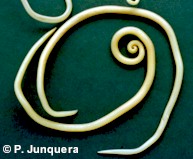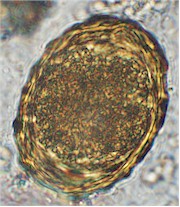Ascaris suum, also called the large pig roundworm or the large white worm, is a species of parasitic roundworms that infects pigs and wild boars worldwide. Prevalence is often very high, especially in tropical countries. Abattoir surveys in Europe indicate that prevalence is higher than 30%. Studies in Canada showed over 60% of the pigs to have been infected with this worm. In fact, it is the most common and damaging pig helminth parasite.
Other mammals, including cattle, sheep and other ruminants can become infected with eggs of Ascaris suum, but these eggs do not complete development to adult worms in these hosts.
 Ascaris lumbricoides, a related species, is a human parasite.
Ascaris lumbricoides, a related species, is a human parasite.
The disease caused by Ascaris roundworms is called ascariasis, sometimes ascariosis.
Are pigs or other animals infected with Ascaris worms contagious for humans?
Probably YES. Ascaris suum eggs in pig manure and in the environment of pigs can infect humans. Some authors consider Ascaris suum and Ascaris lumbricoides, the human parasite, to be the same species: they are morphologically identical and in some regions human Ascaris infections and contact with pigs or pig manure seem to be associated.
You can find additional information in this site on the general biology of parasitic worms and/or roundworms.
Final location of Ascaris suum
Predilection site of adult Ascaris suum is the small intestine.
Anatomy of Ascaris suum

Adult Ascaris suum are rather large worms. They can be up to 50 cm long and up to 6 mm thick. They have a whitish color. Females are larger than males. Their mouth has three lips with numerous small teeth. As other roundworms the body of Ascaris suum covered with a cuticle, which is flexible but rather tough.
The worms have no external signs of segmentation. They have a tubular digestive system with two openings. They also have a nervous system but no excretory organs and no circulatory system, i.e. neither a heart nor blood vessels. Males have two spicules for attaching to the female during copulation.
The eggs are oval, about 40x60 micrometers, have a brownish to yellowish color, a thick membrane, and a rough surface.
Life cycle of Ascaris suum
Ascaris suum has a direct life cycle, i.e. there are no intermediate hosts. Adult females lay 1 million eggs and more daily, which are shed with the feces. These eggs are extremely resistant to dryness, freezing and disinfectants, and can remain infective in the environment for five years and beyond. These means that in most pig production facilities the environment is very likely to be contaminated with Ascaris suum eggs. Sunlight and persistent dryness will kill the eggs.
Depending on temperature and humidity, within 2 to 6 weeks L2-larvae develop inside the eggs in the environment and become infective. In warm regions this will allow several generations each year. In cold regions egg development in the environment is often only possible during the summer months a may allow only one generation per year. However confined facilities that are heated are likely to support more than one generation a year.
Harm caused by Ascaris suum infections, symptoms and diagnosis
Ascaris suum is the most damaging worm of swine. Harm caused by migrating larvae is substantial. Affected livers (milky spots) are rejected at slaughter. Massive migrations in the lungs can cause pneumonia, bleedings, edema, emphysema (lung obstruction), etc. followed by secondary bacterial infections, manifested by typical respiratory symptoms (coughing, difficult breathing, etc.). Deaths are not infrequent. Young pigs are more susceptible.
A few adult worms in the gut are relatively harmless. But massive infections can obstruct the gut or the biliary ducts and cause perforations and peritonitis. Infections with Ascaris suum can also aggravate infectious diseases such as pig influenza.
Economic loss is significant: ~4 USD/animal/year due to liver rejection, higher food conversion (~5%) and growth retardation (~20%).
Diagnosis in pigs is based on clinical symptoms and history, and is confirmed by detection of typical eggs in the feces. Occasionally adult worms are also found in the droppings. However piglets and young animals suffering from larval migration but not yet infected with adult worms do not shed eggs.
In cattle and sheep infected with infective eggs the larvae may migrate to the liver and the lungs, but do not continue development to adult worms. Nevertheless such infected cattle, sheep and other ruminants can show asthma-like respiratory symptoms and also milky spots in the livers.
Prevention and control of Ascaris suum infections
A strict hygiene in indoor facilities can reduce the number of infective eggs in the immediate environment of the pigs. This is much more difficult to achieve in pigs kept outdoors.
Pigs can develop natural resistance to Ascaris suum, but not to the extent that they become worm free. The worms may not harm them seriously, but they will keep producing eggs shed with the feces of the infested pigs. This means that such naturally resistant pigs will continue contaminating their environment with worm eggs.
So far, the periodic use of adequate anthelmintics is normally imperative in most operations. It is often recommended to treat the sows before mating and again after farrowing. Piglets should be treated after weaning, before putting them into clean boxes. Boars should be treated every 6 months.
Numerous anthelmintics are effective against Ascaris suumadults in pigs, e.g. several benzimidazoles (albendazole, fenbendazole, flubendazole, mebendazole, oxfendazole, etc.), levamisole, as well as several macrocyclic lactones (e.g. abamectin, doramectin, ivermectin, moxidectin), the latter are usually also effective against migrating larvae. Piperazine derivatives are cheaper and effective against the adults, but not against the immatures.
Depending on the country, most of these anthelmintics are available for oral administration as feed additives or drenches. Levamisole and most macrocyclic lactones are usually also available as injectables.
There are so far no true vaccines against Ascaris suum. To learn more about vaccines against parasites of livestock and pets click here.
Biological control of Ascaris suum (i.e. using its natural enemies) is so far not feasible. Learn more about biological control of worms.
You may be interested in an article in this site on medicinal plants against external and internal parasites.
Resistance of Ascaris suum to anthelmintics
So far there are no reports on resistance of Ascaris suum to anthelmintics.
This means that if an anthelmintic fails to achieve the expected efficacy, chance is very high that either the product was unsuited for the control of Ascaris suum, or it was used incorrectly.
Learn more about parasite resistance and how it develops.
|
Ask your veterinary doctor! If available, follow more specific national or regional recommendations for Ascaris suum control. |